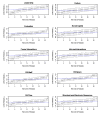Assessment of variation in the Alberta Context Tool: the contribution of unit level contextual factors and specialty in Canadian pediatric acute care settings
- PMID: 21970404
- PMCID: PMC3200177
- DOI: 10.1186/1472-6963-11-251
Assessment of variation in the Alberta Context Tool: the contribution of unit level contextual factors and specialty in Canadian pediatric acute care settings
Abstract
Background: There are few validated measures of organizational context and none that we located are parsimonious and address modifiable characteristics of context. The Alberta Context Tool (ACT) was developed to meet this need. The instrument assesses 8 dimensions of context, which comprise 10 concepts. The purpose of this paper is to report evidence to further the validity argument for ACT. The specific objectives of this paper are to: (1) examine the extent to which the 10 ACT concepts discriminate between patient care units and (2) identify variables that significantly contribute to between-unit variation for each of the 10 concepts.
Methods: 859 professional nurses (844 valid responses) working in medical, surgical and critical care units of 8 Canadian pediatric hospitals completed the ACT. A random intercept, fixed effects hierarchical linear modeling (HLM) strategy was used to quantify and explain variance in the 10 ACT concepts to establish the ACT's ability to discriminate between units. We ran 40 models (a series of 4 models for each of the 10 concepts) in which we systematically assessed the unique contribution (i.e., error variance reduction) of different variables to between-unit variation. First, we constructed a null model in which we quantified the variance overall, in each of the concepts. Then we controlled for the contribution of individual level variables (Model 1). In Model 2, we assessed the contribution of practice specialty (medical, surgical, critical care) to variation since it was central to construction of the sampling frame for the study. Finally, we assessed the contribution of additional unit level variables (Model 3).
Results: The null model (unadjusted baseline HLM model) established that there was significant variation between units in each of the 10 ACT concepts (i.e., discrimination between units). When we controlled for individual characteristics, significant variation in the 10 concepts remained. Assessment of the contribution of specialty to between-unit variation enabled us to explain more variance (1.19% to 16.73%) in 6 of the 10 ACT concepts. Finally, when we assessed the unique contribution of the unit level variables available to us, we were able to explain additional variance (15.91% to 73.25%) in 7 of the 10 ACT concepts.
Conclusion: The findings reported here represent the third published argument for validity of the ACT and adds to the evidence supporting its use to discriminate patient care units by all 10 contextual factors. We found evidence of relationships between a variety of individual and unit-level variables that explained much of this between-unit variation for each of the 10 ACT concepts. Future research will include examination of the relationships between the ACT's contextual factors and research utilization by nurses and ultimately the relationships between context, research utilization, and outcomes for patients.
Figures
Similar articles
-
Development and assessment of the Alberta Context Tool.BMC Health Serv Res. 2009 Dec 15;9:234. doi: 10.1186/1472-6963-9-234. BMC Health Serv Res. 2009. PMID: 20003531 Free PMC article.
-
Advancing the argument for validity of the Alberta Context Tool with healthcare aides in residential long-term care.BMC Med Res Methodol. 2011 Jul 18;11:107. doi: 10.1186/1471-2288-11-107. BMC Med Res Methodol. 2011. PMID: 21767378 Free PMC article.
-
Predicting research use in nursing organizations: a multilevel analysis.Nurs Res. 2007 Jul-Aug;56(4 Suppl):S7-23. doi: 10.1097/01.NNR.0000280647.18806.98. Nurs Res. 2007. PMID: 17625477
-
Quality improvement research in pediatric hospital medicine and the role of the Pediatric Research in Inpatient Settings (PRIS) network.Acad Pediatr. 2013 Nov-Dec;13(6 Suppl):S54-60. doi: 10.1016/j.acap.2013.04.006. Acad Pediatr. 2013. PMID: 24268086 Review.
-
Organization-Wide Approaches to Foster Effective Unit-Level Efforts to Improve Clinician Well-Being.Mayo Clin Proc. 2023 Jan;98(1):163-180. doi: 10.1016/j.mayocp.2022.10.031. Mayo Clin Proc. 2023. PMID: 36603944 Review.
Cited by
-
A pragmatic cluster randomised trial evaluating three implementation interventions.Implement Sci. 2012 Aug 30;7:80. doi: 10.1186/1748-5908-7-80. Implement Sci. 2012. PMID: 22935241 Free PMC article. Clinical Trial.
-
Characterizing worker compensation claims in long-term care and examining the association between facility characteristics and severe injury: a repeated cross-sectional study from Alberta, Canada.Hum Resour Health. 2023 Aug 16;21(1):63. doi: 10.1186/s12960-023-00850-4. Hum Resour Health. 2023. PMID: 37587454 Free PMC article.
-
Students' attitudes and perceptions of teaching and assessment of evidence-based practice in an occupational therapy professional Master's curriculum: a mixed methods study.BMC Med Educ. 2017 Mar 27;17(1):64. doi: 10.1186/s12909-017-0895-2. BMC Med Educ. 2017. PMID: 28347300 Free PMC article.
-
The role of organizational context in moderating the effect of research use on pain outcomes in hospitalized children: a cross sectional study.BMC Health Serv Res. 2017 Jan 23;17(1):68. doi: 10.1186/s12913-017-2029-2. BMC Health Serv Res. 2017. PMID: 28114940 Free PMC article.
-
A strategic initiative to facilitate knowledge translation research in rehabilitation.BMC Health Serv Res. 2020 Oct 23;20(1):973. doi: 10.1186/s12913-020-05772-8. BMC Health Serv Res. 2020. PMID: 33097043 Free PMC article.
References
-
- Dopson S, Fitzgerald L, (eds.) Knowledge to Action: Evidence-Based Health Care in Context. Oxford: Oxford University Press; 2005.
-
- Scott-Findlay S, Golden-Biddle K. Understanding how organizational culture shapes research use. J Nurs Adm. 2005;35(7-8):359–365. - PubMed
-
- Stetler C. Role of the organization in translating research into evidence-based practice. Outcome Manag. 2003;7(3):97–105. - PubMed
Publication types
MeSH terms
Grants and funding
LinkOut - more resources
Full Text Sources
Medical
Miscellaneous


